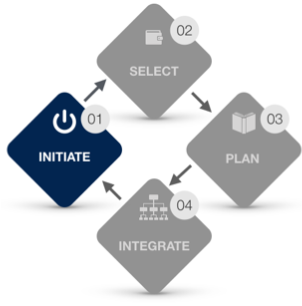3 Step 1: Initiate
“Start with the end in mind.”
― Stephen R. Covey
The Lean Deployment Plan is intended to be developed following the formation of the project team, and the validation of the client’s business plan for the project. Depending on the project team’s awareness and understanding of lean, the lean deployment planning can be made more effective by: appointing a lean coach, who has experience with lean implementation; developing a facilitation agenda and presentation; and, scheduling the lean deployment kick-off, which is essentially a planning session, where the key stakeholders collaboratively develop the lean deployment plan for the project using the resource templates provided in this guide.
Lean Coach
The project leadership is responsible for identifying a suitable lean coach for the project. The lean coach can vary from someone in-house to a third party consultant, depending on the project team’s maturity towards lean. By helping to identify and fulfill the project team’s need for lean education and training, the lean coach is responsible for helping the project team’s overall alignment to lean principles and practices. They should be knowledgeable of the array of lean methods and how they should be implemented throughout projects.
Lean Deployment Kick-off
The lean coach and the project leadership should then schedule the lean deployment kick-off and develop an agenda that walks the team through the planning procedure and the templates in this guide. Although the kick-off is a one-time session, the planning process can also be spread over multiple sessions depending on the project team’s capacity and availability.
Project Conditions of Satisfaction (P-COS)
A prerequisite for developing the lean deployment plan is to have a clear understanding of the client’s needs from the project. The client needs are usually captured in the project conditions of satisfaction (P-COS) during the validation phase and represent the value proposition for the project, which needs to be captured in the lean deployment plan.
If the P-COS has not been developed, then it should be discussed and developed collaboratively at the lean deployment planning kick-off with project leaders, who understand the client’s needs.
A one-page summary, including some examples of P-COS is provided in the appendix, which can be used to understand how P-COS can be developed. For the planning purposes in this guide, we refer to the overall project’s conditions of satisfaction versus the criteria for work hand-offs between phases.
We define the Project Conditions of Satisfaction (P-COS) as a set of criteria that are developed based on the client’s business needs from the project and, act as a baseline for the project team in making decisions along with the project duration. These conditions serve as common ground rules for planning and performing work as per the client’s satisfaction and all members are jointly responsible. Simply put, they function as the critical success factors for the project, which the team should consider throughout the project timeline.
Lean Champion(s)
Following the P-COS recorded as part of the plan, the project leaders should identify lean champion(s). A lean champion is different from a lean coach. A lean champion needs to be someone from within the project team, who serves as a role model in aligning with lean thinking and action while spearheading the implementation process. The lean champion will be responsible for overseeing the deployment of lean on the project, implementing the plan.
Deployment Planning
Once all the preparations, such as the scheduled kick-off, agenda, presentation, lean coach, P-COS, and lean champion, are in order, the planning for lean deployment can be facilitated in one session (3 to 4 hours) or over multiple follow-up sessions (example: 1 hour each) depending on the project team’s schedule and capacity. Prior to onboarding members on this path, some members may require foundational lean education/training, which can be provided by the lean coach.
a set of criteria that are developed based on the client’s business needs from the project and, act as a baseline for the project team in making decisions along with the project duration.


